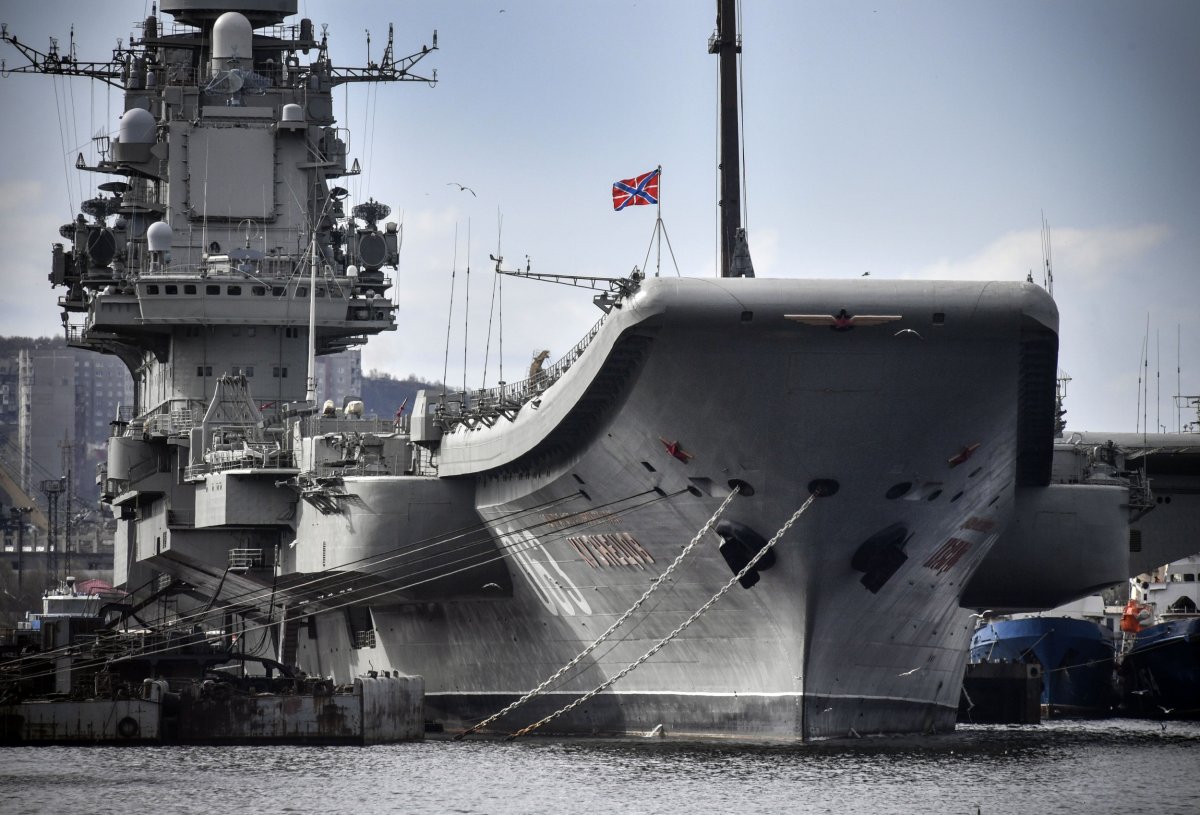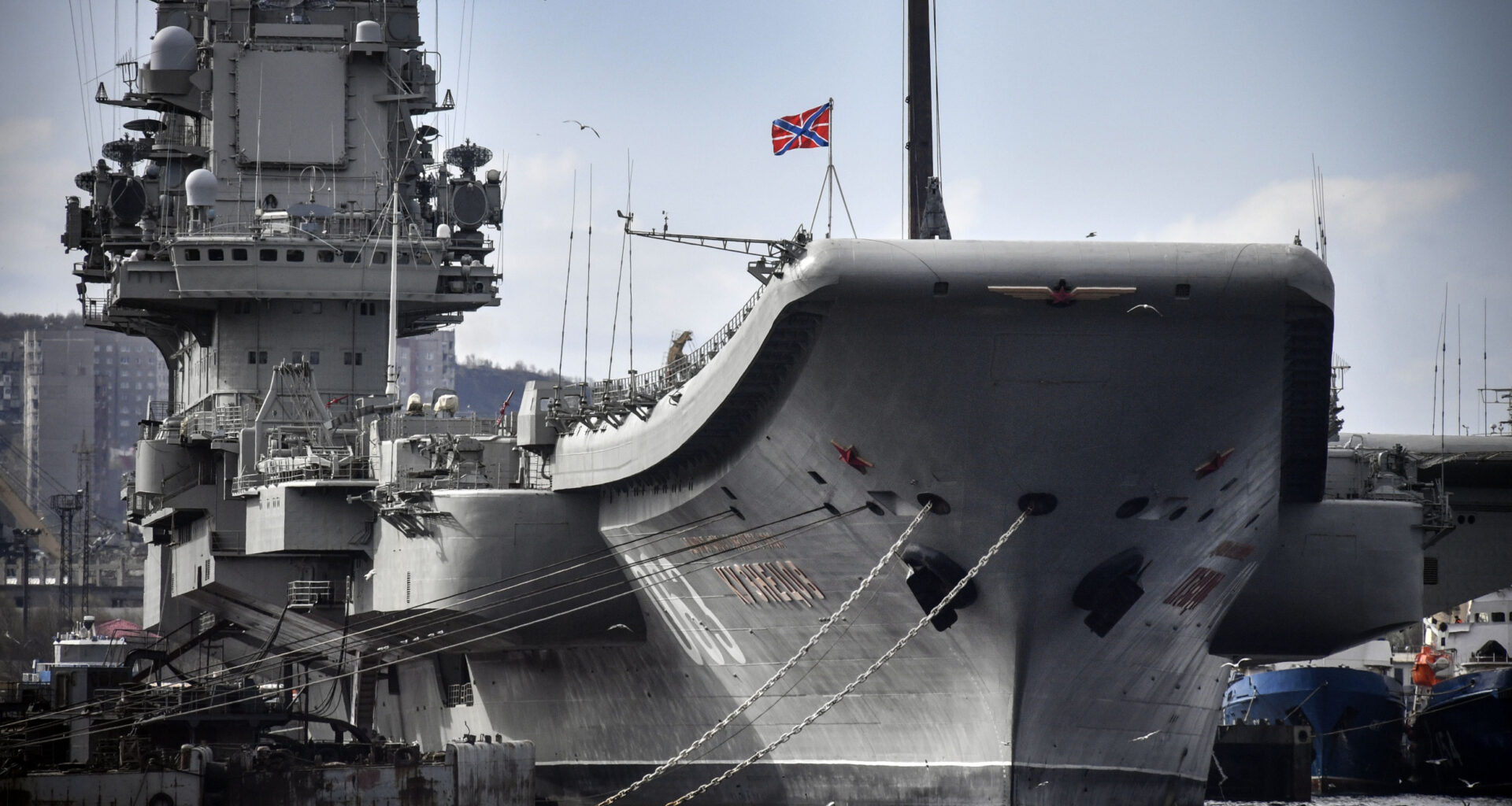Russia’s only aircraft carrier, the Admiral Kuznetsov, is likely to be sold or scrapped, marking the end of a vessel that was once a symbol of Moscow’s naval ambition.
The fate of the 40-year-old flagship of the Russian Navy had hung in the balance following years of repairs, having been out of service since 2017, and maintenance work suspended.
However, Andrei Kostin, the chairman of Russia’s state shipbuilding corporation (USC), told the newspaper Kommersant that “there is no point repairing it anymore.”
Yörük Işık, head of the Bosphorus Observer consultancy in Istanbul, told Newsweek on Monday that such a move meant “a loss of prestige” for Russia’s Navy.
Newsweek reached out to USC and the Russian Defense Ministry for comment.
Why It Matters
The Admiral Kuznetsov was launched in 1985, and while it had seen action in Moscow’s military campaign in Syria, it has been out of service for eight years.
Years of maintenance delays and increasing costs have raised questions about its technical effectiveness in modern warfare. But its scrapping will be seen as a sign of a diminishing Russian naval capability, especially as Ukrainian drones have chased most of its Black Sea Fleet away from its main base in Crimea.
What To Know

Russian aircraft carrier Admiral Kuznetsov tied up at a Rosatomflot moorage of the Russian northern port city of Murmansk on May 19, 2018.
Russian aircraft carrier Admiral Kuznetsov tied up at a Rosatomflot moorage of the Russian northern port city of Murmansk on May 19, 2018.
ALEXANDER NEMENOV/Getty Images
The newspaper Izvestia reported earlier in July that the refit of the vessel had been suspended, and Kostin was asked about its fate on the sidelines of a flag-raising ceremony for a new nuclear submarine in northwestern Russia.
Kostin confirmed the reports, telling Kommersant that there was no point in repairing it and that it will either be sold or disposed of, although no final decision had been taken.
The 1000-foot-long Admiral Kuznetsov was the last heavy aircraft carrier built in the Soviet Union and was designed to combine aviation capabilities with strike capabilities.
After the Soviet Union collapsed, the ship was transferred to Russia’s Northern Fleet and was used in Russia’s intervention in the Syrian civil war.
It displaced 59,000 tons, had a range of 8,400 nautical miles and could carry a crew of 2,600 and hold 26 fixed-wing aircraft and 24 helicopters.
But the carrier has faced technical problems, and The National Interest included it in a list of the world’s worst aircraft carriers.
A refit was scheduled to be completed by 2022 at the Zvyozdochka shipyard in the Barents Sea port city of Murmansk, but the project has been beset by problems and spiraling costs.
In 2018, the floating dry dock where the ship was being repaired sank. The following year, a fire during welding work killed two people, and another fire broke out in 2022.
The estimated cost of repairs has ballooned from 20 billion rubles ($256.4 million) in 2017 to 60 billion rubles ($769.2 million) the following year, and the timeline has been revised from 2022 to 2024, with no plans for its return yet.
Işık, from the Bosphorus Observer, told Newsweek that, given it had been out of service for years, the exit of the vessel did not change much strategically but dealt a significant psychological blow to Russia’s status as a naval power.
Ukraine’s “ingenious and out-of-the-box thinking” in striking Russia’s Black Sea vessels has shown how naval war is changing, he said.
“To extend power in far corners of the world, you need such vessels and Russia giving up the only such vessel it has like this means a loss of prestige,” he added.

Russian President Vladimir Putin at the Baltic Shipyard in St. Petersburg with Andrei Kostin, chairman of the United Shipbuilding Corporation, on January 26, 2024.
Russian President Vladimir Putin at the Baltic Shipyard in St. Petersburg with Andrei Kostin, chairman of the United Shipbuilding Corporation, on January 26, 2024.
Getty Images
Russia’s Navy vs. U.S. Navy
Russia’s Navy is ranked the world’s number three, according to Military Watch Magazine and lags behind the U.S., which is number one.
The loss of the Admiral Kuznetzov would mean that Russia would have no aircraft carriers. However, under Russian classification, the vessel is designated a heavy aircraft cruiser, which allows it to transit the Turkish Straits.
The U.S. has 11 supercarriers to Russia’s zero, which can deploy over 70 combat aircraft from multiple runways with catapult-assisted takeoffs. There are also 92 American cruisers/destroyers to Russia’s 13, while the U.S. has more than twice as many frigates (21 to 10) as Russia.
The countries’ submarines are relatively close in number, with the U.S. having 53 attack submarines to Russia’s 28, while there are 14 American ballistic missile submarines to Russia’s 11.
What People Are Saying
Chairman of Russia’s state shipbuilding corporation (USC) Andrei Kostin told Kommersant: “There is no point in repairing (the Admiral Kuznetsov) anymore. It is over 40-years old, and it is extremely expensive.”
Yörük Işık, head of the Bosphorus Observer consultancy in Istanbul, told Newsweek that the loss of the vessel “in psychological terms is huge.”
Former Pacific Fleet Commander Admiral Sergey Avakyants told Izvestia that aircraft carriers like the Admiral Kuznetsov: “Are a thing of the past — massive and costly structures that can be destroyed within minutes by modern weapons.”
What Happens Next
Russian President Vladimir Putin has signaled plans for military spending cuts starting next year. It is unclear whether the fate of the Admiral Kuznetsov will be part of these considerations, but Kostin’s comments suggest a final decision has not yet been made.
